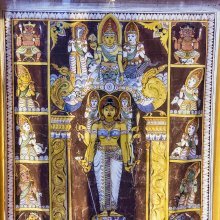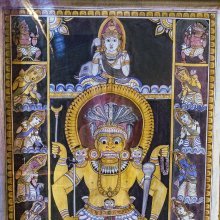Baliya, Baḷiyā, Baliyā: 4 definitions
Introduction:
Baliya means something in the history of ancient India, Marathi. If you want to know the exact meaning, history, etymology or English translation of this term then check out the descriptions on this page. Add your comment or reference to a book if you want to contribute to this summary article.
Images (photo gallery)
India history and geography
Source: Shodhganga: A study of place names of Nalgonda districtBaliya is one of the terms designating an ‘administrative division’ used in the inscriptions of Andhra Pradesh.—This term was at times employed to denote a kampana. The Kollipaka inscriptions of the Kalyana Chalukya king Vikramaditya-VI use the term baliya instead of kampana.

The history of India traces the identification of countries, villages, towns and other regions of India, as well as mythology, zoology, royal dynasties, rulers, tribes, local festivities and traditions and regional languages. Ancient India enjoyed religious freedom and encourages the path of Dharma, a concept common to Buddhism, Hinduism, and Jainism.
Languages of India and abroad
Marathi-English dictionary
Source: DDSA: The Molesworth Marathi and English Dictionarybaḷiyā (बळिया).—a (Poetry. baḷa) Strong. Ex. tasmāt prāktana rē samartha || ba0 lallāṭarēṣā kharī ||.
Marathi is an Indo-European language having over 70 million native speakers people in (predominantly) Maharashtra India. Marathi, like many other Indo-Aryan languages, evolved from early forms of Prakrit, which itself is a subset of Sanskrit, one of the most ancient languages of the world.
Kannada-English dictionary
Source: Alar: Kannada-English corpusBaliya (ಬಲಿಯ):—[noun] a physically strong man.
--- OR ---
Baḷiya (ಬಳಿಯ):—[noun] an obedient, submissive man.
--- OR ---
Baḻiya (ಬೞಿಯ):—[noun] an obedient, submissive man.
Kannada is a Dravidian language (as opposed to the Indo-European language family) mainly spoken in the southwestern region of India.
Nepali dictionary
Source: unoes: Nepali-English DictionaryBaliyā (बलिया):—adj. pl. of बलियो [baliyo]
Nepali is the primary language of the Nepalese people counting almost 20 million native speakers. The country of Nepal is situated in the Himalaya mountain range to the north of India.
See also (Relevant definitions)
Starts with: Baliyabanga, Baliyakkha, Baliyam, Baliyams, Baliyas, Baliyasa, Baliyasama, Baliyastara, Baliyastva, Baliyati, Baliyatra, Baliyattu.
Ends with: Baibaliya, Dehambaliya, Dubbaliya, Dubbaliya, Kabaliya, Kambaliya, Shabaliya.
Relevant text
Search found 6 books and stories containing Baliya, Baḷiyā, Baliyā, Baḷiya, Baḻiya; (plurals include: Baliyas, Baḷiyās, Baliyās, Baḷiyas, Baḻiyas). You can also click to the full overview containing English textual excerpts. Below are direct links for the most relevant articles:
Chaitanya Bhagavata (by Bhumipati Dāsa)
Verse 2.13.286 < [Chapter 13 - The Deliverance of Jagāi and Mādhāi]
Verse 1.11.50 < [Chapter 11 - Meeting with Śrī Īśvara Purī]
Verse 3.3.94 < [Chapter 3 - Mahāprabhu’s Deliverance of Sarvabhauma, Exhibition of His Six-armed Form, and Journey to Bengal]
Gati in Theory and Practice (by Dr. Sujatha Mohan)
Gati in classical form of Kathakali < [Chapter 4 - Practice of Gati]
Buddhist records of the Western world (Xuanzang) (by Samuel Beal)
Chapter 2 - Country of Chen-chu (Ghazipur) < [Book VII - Five Countries]
Shri Gaudiya Kanthahara (by Srila Bhaktisiddhanta Sarasvati)
Srila Gurudeva (The Supreme Treasure) (by Swami Bhaktivedanta Madhava Maharaja)
The Glory of Bhakti < [Chapter 2.11 - Why He Came? The Contribution of Śrīla Gurudeva]
The Four Most Prominent Types of Ṛtviks (priests) < [Chapter 2.10 - There is No Place for Ṛtvik in Śrī Guru-Tattva]
Folk Tales of Gujarat (and Jhaverchand Meghani) (by Vandana P. Soni)
Chapter 6 - Natho Modhvadio (Around 1830) < [Part 2 - Sorathi Baharvatiya]

